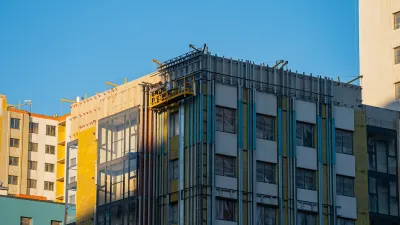As the current fascination with all things green grows with leaps and bounds, the question arises – are there any limits to what can be green?
As the current fascination with all things green grows with leaps and bounds, the question arises – are there any limits to what can be green?
In recent weeks I have seen articles in the Los Angeles Times magazine about how environmentalists are teaming with Wall Street investment banks to create green investment products and that a group of green leaning investors purchased the Texas-based utility TXU. Right down the street from my office is the world's first green parking structure. Can Wall Street, the belly of short-horizon, profit-based capitalism beast truly be developing an environmental consciousness? Can a hydrocarbon-based utility ever become green, no matter what commitments it makes to stop burning coal and reduce carbon emissions? Is greening a warehouse for one of the most egregious environmental villains– the personal automobile – an exercise in inspired design or futility?
Well, I think that for sustainability to have the possibility to effect the status quo in a meaningful way these types of turn-the-stereotype-on-its-head efforts are exactly what is needed. So I encourage us to find the green opportunity where nothing seems to exist, in the rooftop, sidewalk, alley, city yard, landfill, general plan, air quality management plan, economic development plan.
By looking beyond the self-imposed boundaries about what is green and what is not, we may be able to see the opportunities for synergy and integration that can make green an expectation rather than a newsworthy aberration.
(I had the chance to talk in some depth about these issues a couple of weeks ago on the KCRW program Design and Architecture.)

Alabama: Trump Terminates Settlements for Black Communities Harmed By Raw Sewage
Trump deemed the landmark civil rights agreement “illegal DEI and environmental justice policy.”

Planetizen Federal Action Tracker
A weekly monitor of how Trump’s orders and actions are impacting planners and planning in America.

The 120 Year Old Tiny Home Villages That Sheltered San Francisco’s Earthquake Refugees
More than a century ago, San Francisco mobilized to house thousands of residents displaced by the 1906 earthquake. Could their strategy offer a model for the present?

Ken Jennings Launches Transit Web Series
The Jeopardy champ wants you to ride public transit.

BLM To Rescind Public Lands Rule
The change will downgrade conservation, once again putting federal land at risk for mining and other extractive uses.

Indy Neighborhood Group Builds Temporary Multi-Use Path
Community members, aided in part by funding from the city, repurposed a vehicle lane to create a protected bike and pedestrian path for the summer season.
Urban Design for Planners 1: Software Tools
This six-course series explores essential urban design concepts using open source software and equips planners with the tools they need to participate fully in the urban design process.
Planning for Universal Design
Learn the tools for implementing Universal Design in planning regulations.
Clanton & Associates, Inc.
Jessamine County Fiscal Court
Institute for Housing and Urban Development Studies (IHS)
City of Grandview
Harvard GSD Executive Education
Toledo-Lucas County Plan Commissions
Salt Lake City
NYU Wagner Graduate School of Public Service






























